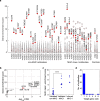Accelerating target deconvolution for therapeutic antibody candidates using highly parallelized genome editing
- PMID: 33627649
- PMCID: PMC7904777
- DOI: 10.1038/s41467-021-21518-4
Accelerating target deconvolution for therapeutic antibody candidates using highly parallelized genome editing
Abstract
Therapeutic antibodies are transforming the treatment of cancer and autoimmune diseases. Today, a key challenge is finding antibodies against new targets. Phenotypic discovery promises to achieve this by enabling discovery of antibodies with therapeutic potential without specifying the molecular target a priori. Yet, deconvoluting the targets of phenotypically discovered antibodies remains a bottleneck; efficient deconvolution methods are needed for phenotypic discovery to reach its full potential. Here, we report a comprehensive investigation of a target deconvolution approach based on pooled CRISPR/Cas9. Applying this approach within three real-world phenotypic discovery programs, we rapidly deconvolute the targets of 38 of 39 test antibodies (97%), a success rate far higher than with existing approaches. Moreover, the approach scales well, requires much less work, and robustly identifies antibodies against the major histocompatibility complex. Our data establish CRISPR/Cas9 as a highly efficient target deconvolution approach, with immediate implications for the development of antibody-based drugs.
Conflict of interest statement
J.M., I.T. and B.F. are employed by BioInvent International AB. The remaining authors declare no competing interest.
Figures



References
Publication types
MeSH terms
Substances
LinkOut - more resources
Full Text Sources
Other Literature Sources
Research Materials

